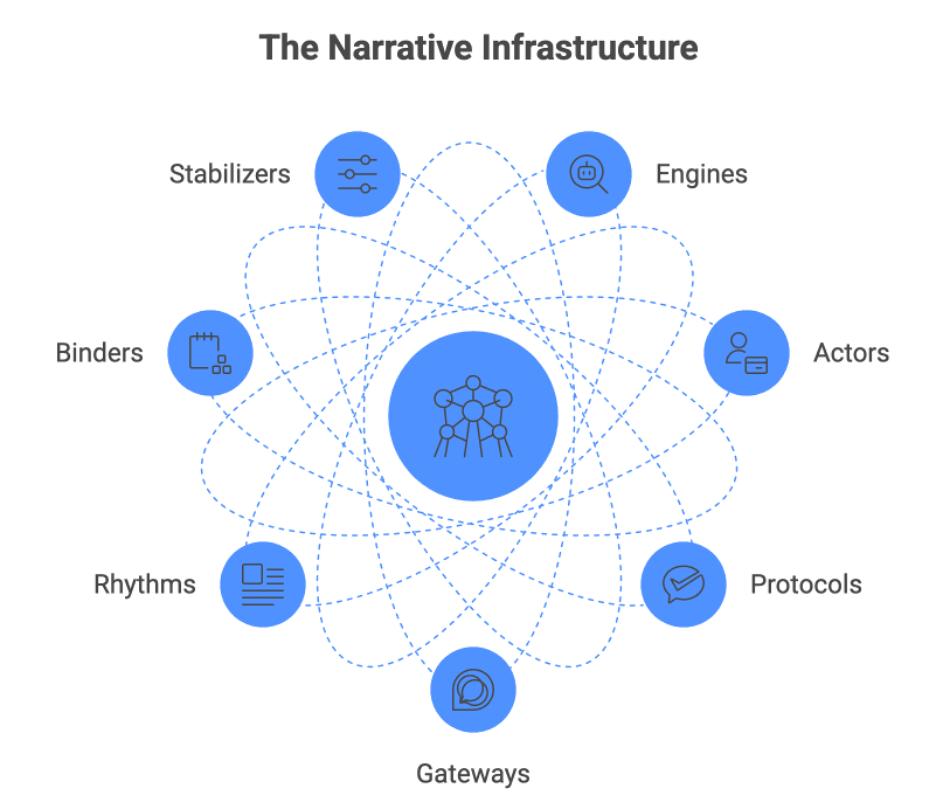Narrative, Not Facts: The Authenticity Playbook
We carefully craft crisis communications, consulting legal to ensure correctness. Yet, behind the scenes, a different game unfolds—narratives where old rules of perfection no longer apply. The winner is now the most authentic, not necessarily the fastest.

We put so much care into our crisis communications work, crafting thoughtful statements and running them by legal to make sure everything is just right. We’re doing the responsible thing. But in the background, a completely different game is being played. It’s the game of narratives, a game where the old rules of polished perfection no longer apply. The winner isn’t just the fastest; it's the most authentic.
The Infrastructure Problem
Think about it. A misleading video can capture a huge audience in the time it takes us to simply schedule a team meeting on an emerging crisis. By the time our carefully vetted, factual statement is released, the public narrative has often already hardened. We’re no longer defining the story; we’re trying to correct it. It’s a race against the clock, and we need to be equipped to win in those crucial first moments.
It’s a tough feeling, realizing we’re not in control of our own brand's story anymore. The real problem isn't just about misinformation. It's the automated system that has become the new storyteller. We’re talking about the machinery that works behind our screens. The ranking engines (SEO, GEO), the recommendation feeds on social media, even the autocomplete that finishes our sentences. These systems decide what people see first, how fast a story spreads, and which parts of it stick in their minds. This means the old playbook of waiting silently and then correcting the record later is obsolete. It’s too slow. The only way to navigate this is to get ahead of the story, building up credibility and getting our allies ready before a negative narrative has a chance to set in stone.
So, let's pull back the curtain. We can break down how this system actually works, look at the predictable stages every narrative goes through, and lay out a practical 72-hour playbook that can be used when things get tough.
The Narrative Infrastructure
When we want to understand why certain narratives take off and others just disappear, it helps to see it as a system. It's more than some random chaos. There are really seven key parts working together that decide which version of a narrative ends up winning.

Let's walk through these moving parts one by one. It's almost like looking at the blueprints of how narratives are built online.
The Engines. First, we have the algorithms themselves. Think of them as the powerful currents that guide everything. These search algorithms and recommendation feeds aren't designed to find the "truth." They're designed to find what's interesting. They steer our attention to whatever gets the most reaction, not what’s most accurate. So we’re not in a debate about facts. Instead, we're in a competition for engagement.
The Actors. This is everyone and everything creating the noise. It includes real people, big institutions, and a whole lot of automated bot accounts. The platforms reward whoever is the fastest and loudest. A quick, provocative claim will always travel further and faster than a slow, carefully considered truth.
The Protocols. Every platform has its own set of rules, both written and unwritten. The format, the tone, the community guidelines… they all shape what can be said and who gets to see it. If we don't know the rules of the road for each platform, we can't time our message or get it to the right people.
The Gateways. These are the main entry points to widespread public attention. We’re talking about the trending topics list, the top results on SEO, GEO, or the news carousels that pop up on our phones. For our story to reach a big audience, it has to pass through one of these major checkpoints.
The Rhythms. Information has a pulse, a speed at which it flows. During a crisis, that pulse starts racing. Everything accelerates. If we’re only communicating sporadically, dropping in once a day with an update, we'll be left behind. The pace of the conversation will completely outrun us.
The Binders. These are the little things that make a story stick. A recurring hashtag, a particular phrase, or even a meme. They act like glue, tying a bunch of scattered posts into one coherent, powerful narrative. Without our own consistent binders, our side of the story will just feel fragmented and fall apart.
The Stabilizers. And finally, we have our anchors. In the middle of an information storm, these are the things people can hold onto for trust. Our official website, a credible expert speaking on the record, clear disclosures. These are the foundations of credibility when everything else feels like chaos.
The Five-Stage Story Arc
Every story unfolds in five stages.

Ignition: A trigger appears. A post spikes, an image circulates, or a problematic AI answer gets shared. These first hours frame the entire issue. Hesitation hands control to others.
Acceleration: Platform engines amplify the initial narrative based on engagement, causing velocity to compound. Pre-planned communication cadence is crucial here. Sporadic updates get outpaced.
Reframing: The first intervention opportunity. Shift the narrative lens with new facts, better visuals, or authentic human voices. Deploy stabilizers to re-anchor the story in credible ground.
Saturation: Peak public attention where simple repetition yields diminishing returns. Adding noise is counterproductive. Pivot from broadcasting to consolidating around a single authoritative hub.
Settlement: Dominant public understanding solidifies. This outcome reflects all previous stages. Successful use of stabilizers and binders settles the narrative closer to facts. Failure creates expensive correction campaigns.
Four Levels To Weave Authenticity In Your Strategy
Pacing Lever: Beat Platform Velocity
Controls: Rhythms, Gateways
We have to remember that these platform algorithms are built for one thing speed. They are absolute speed demons. They are designed to amplify whatever is moving the fastest, right now. So if we’re waiting for the green light from legal, or trying to get every single fact perfect before we say anything... we’ve already lost. The window has closed.
A telecom company facing service outages posting updates every two hours during prime social media time slots, even when they had no new technical details. Sometimes, the update was simply, “We’re still working on it, and we'll have more information soon.” But what they did was occupy the space. They didn't leave a void. Silence is a vacuum, and people will rush to fill it with rumors and worst-case scenarios. By keeping up a steady rhythm, they prevented conspiracy theories from taking hold and kept their own voice in the center of the conversation.
Here’s a simple way to think about it: look at when the conversation is actually happening. If we notice that maybe 80% of all the chatter is crammed into just 10% of the day, we're officially in crisis velocity mode. We either match that rhythm, or we get buried. It's really that simple.
Messaging Lever: Preserve Authenticity
Controls: Binders, Actors
It's so tempting to use AI writing tools to smooth everything out, but this can really backfire during a tough situation. These tools often sand down all the human edges, those little imperfections that make writing feel real. What we're left with is a message that sounds like it came straight from a corporate communications textbook. People can smell that artificial polish from a mile away.
There’s a perfect story about this. A CEO had to write an apology for a product recall. He wrote a very frank and direct message, even mentioning the specific engineering mistakes that were made. It was honest. Then an AI assistant rewrote it, turning it into lifeless corporate speak. When they tested both versions, the original, human one performed three times better with customers. People just wanted to hear a real person taking accountability.
It’s something to watch for in our own communications. Just count how many cookie-cutter phrases we find in a message. A high number is a warning sign that we're losing our authentic voice. That’s the cue to pull back from the AI and let real people do the talking.
Localization Lever: Demonstrate Ground Truth
Controls: Protocols, Binders
There's almost nothing that makes a company look more out of touch than sending out a generic, worldwide statement when a local community is dealing with a very specific problem. It just feels... disconnected. Authenticity means showing that we’re on the ground.
And here's the interesting part - the algorithms actually reward us for being specific. It makes sense, isn’t it? Content that shows real, on-the-ground awareness gets much higher engagement from the people who are actually affected, and the platforms notice that and boost it.
A food manufacturer was fighting contamination rumors. Instead of a vague corporate message, they got specific. They named the exact facility locations, provided contact information for local health departments, and gave out regional distribution timelines. Meanwhile, their competitors put out generic statements and were completely ignored. The specific response dominated the search results and trending feeds.
It's something we can easily keep an eye on. Just look at our message and count the number of concrete details such as places, names, specific policies. If that number is low, we can almost guarantee we're going to have a big fight later on, trying to convince people we're not disconnected from their reality.
Human Handover Lever: Provide Expert Access
Controls: Stabilizers, Protocols
We have to remember that when people are genuinely stressed or scared, the last thing they want is to be stuck in a loop with a chatbot. When our automated systems hit their limits, we need to give people an obvious escape route to a real person. We have to provide that, no exceptions.
It might seem more expensive to have a human step in, but that cost is nothing compared to the damage done when people lose trust in us because they feel unheard.
There was a hospital system that created a symptom checker. For any answer that seemed even a little bit concerning, it didn't just give more automated questions. It gave people a direct link to a nurse's hotline and a way to book an urgent care appointment. The result? Their patient satisfaction scores jumped by 40%. That’s a huge difference, and it shows what happens when we give people a clear path to real help.
It’s something we need to keep an eye on ourselves. We should track how often our high-stakes interactions offer a clear way to reach a human expert. If that number is low, it’s a big red flag that we're relying too much on our automated systems, and that’s a dangerous gamble. Ultimately, the most authentic response is a real human one.
10-Rule Authenticity Playbook for the First 72 Hours
We're Honest About the Bots. If a machine is helping with our public replies, we should just say so. Being transparent from the start is a simple way for us to build a foundation of trust. We can think of it as a basic anchor people can hold onto.
We Trade Fake Empathy for Real Action. We all know those generic, AI-written lines like "we understand your frustration." They feel empty. Instead of using stock empathy, we need to pair our kind words with a concrete action, like a link to a resource or a direct number to call.
We Create an Obvious Escape Hatch. When the stakes are high, people need a clear path to a human. We shouldn't make them hunt for it. This is probably the most powerful anchor we have. Making it easy to reach an expert shows we're taking the situation, and them, seriously.
We Drop a Local Detail Immediately. In our very first reply, we should try to include at least one specific, local detail. This one small action immediately grounds our response in reality and can save us from a huge, costly fight later on.
We Set the Pace to Control the Story. We need to match the rhythm of the conversation. A steady beat of timed, meaningful updates is far more effective than just posting frantically. This steady presence prevents others from completely taking over the narrative.
We Protect Our Leaders' Real Voices. We need to keep an eye on tools that automatically "clean up" language. They can strip the authenticity right out of a leader's message. That human element is a valuable asset, so we can't let a machine erase it.
We Build One Source of Truth. We can create a single, authoritative webpage. On one side, we'll list the claim being made. On the other, we'll post our counter-evidence. This becomes our home base for reframing the story and a powerful anchor for the public.
We Put a Real Human on the Record. We should get our most credible experts out there where people can see them. In a storm of anonymous noise, the voice of a single, authoritative human is more powerful and believable than almost anything else.
We Set Rules for Our Own AI. We need to have clear guidelines and human oversight for the AI tools we use internally. This ensures our own technology is helping us, not accidentally making the problem worse.
We Watch the Data and We're Ready to Pivot. We need to actively track the key indicators. If we see that the story has peaked and engagement is falling, that's our cue. It's time for us to shift our strategy from broadcasting to focusing on direct help and fixing the problem.ls that automatically scrub authentic language from leadership posts. This prevents high template density and preserves binder credibility.
The 72-Hour Implementation
Hours 1-24: Establish Control (Ignition/Acceleration Stage)
In this initial stage, it's all about establishing control. The very first thing we should do is get our real human experts involved, especially those with specific, local knowledge. At the same time, we create one single place for all official information - a webpage, a dedicated social media thread, something. Our goal is to match the rhythm of the conversation, not our own internal meeting schedule. In this first stage, being fast is more important than being perfect.
Hours 25-48: Hold Position (Reframing Stage)
Now we're in the reframing stage. This is when we take a hard look at any automated messages we're sending. We need to swap out empty phrases like "we understand your concerns" for actual, concrete help and resources. We keep posting updates on a steady schedule, even if we don't have much new information to share. We have to remember that silence creates a vacuum, and someone else will always be happy to fill it.
Hours 49-72: Consolidate Victory (Saturation/Settlement Stage)
As the story reaches its peak and begins to settle, our job changes. We stop shouting our message out to the world (broadcasting) and instead, we focus on directing everyone to that single, authoritative hub we created on day one. We also start preparing for what comes next, because we know public attention will eventually move on.
Implementation Requirements
To make this work, we need a few things in place beforehand. We need a simple way to track those key metrics we talked about, so we can see what's happening in real time. We should have a list of our go-to experts who are pre-approved to speak, so we don't get stuck waiting for permission. We also need clear rules for how we use AI, to make sure it doesn't strip the human voice out of our leaders' messages. And finally, we need to train our team to spot when the speed of the conversation changes, so we can shift our game plan on the fly.
The 30-Second Brief for Leadership
Our biggest challenge has changed. It's no longer just about correcting false stories after they're already out there. It’s about actively managing the systems that shape what our audiences believe about us in the first place.
We shift reactive to proactive. We do this with authenticity.
Our team should now be equipped with four key levers – pacing, messaging, localization, and human handover - to see risks emerging in real-time, along with a 72-hour playbook to act. This new strategy will better protect our reputation, reduce the costs that come with a long crisis cycle, and help us maintain trust in a world where algorithms and AI now have so much influence.


